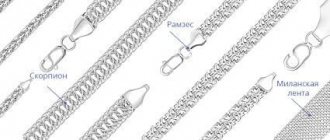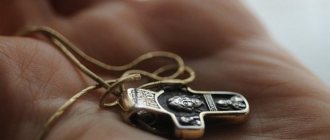Audio version of the article
- History of the Holy Cross K. Parkhomenko
- About the sign of the cross and pectoral crosses Answers to questions
- Holy cross K. Slepinin
- Is it possible to remove a pectoral cross? Deacon Sergius Shalberov
- Truth and myths about the pectoral cross of Rev. Nikolay Markovsky
- Breviary. The rite of blessing the cross to be worn on the chest
- Photo story “Pectoral Cross”
***
A pectoral cross is a small cross that symbolically displays the Cross on which the Lord Jesus Christ was crucified (sometimes with the image of the Crucified One, sometimes without such an image), intended to be constantly worn by an Orthodox Christian as a sign of his faith and fidelity to Christ, belonging to the Orthodox Church, serving as a means for grace-filled protection.
The cross is the greatest Christian shrine, a visible evidence of our redemption. In the service for the Feast of the Exaltation, the Church glorifies the tree of the Cross of the Lord with many praises: “The Cross is the guardian of the entire universe, the beauty of the Church, the power of kings, the affirmation of the faithful, the glory of angels and the plague of demons.”
A pectoral cross is given to a baptized person who becomes a Christian and is constantly worn in the most important place (near the heart) as an image of the Cross of the Lord, an external sign of an Orthodox Christian. This is also done as a reminder that the Cross of Christ is a weapon against fallen spirits, having the power to heal and give life. That is why the Cross of the Lord is called Life-Giving!
He is evidence that a person is a Christian (a follower of Christ and a member of His Church). This is why it is a sin for those who wear a cross for fashion without being a member of the Church. Consciously wearing a cross on the body is a wordless prayer, allowing this cross to demonstrate the true power of the Archetype - the Cross of Christ, which always protects the wearer, even if he does not ask for help, or does not have the opportunity to cross himself.
When performing the sacrament of Baptism, the priest puts a cross on the baby, which from that moment becomes the inseparable companion of the new member of the Church. It is not customary to remove a cross when bathing or changing clothes (in the old days there were even wooden crosses in the baths, which were worn in the steam room instead of their own). Unfortunately, there are also “knowledgeable” advisers: nurses, neighbors, friends who authoritatively convince the mother to remove the cross from the child: they say he is still small, he will get tangled in the ribbon, he will chafe the skin, etc.
There are canonical forms of crosses - four-, six-, eight-pointed; with a semicircle below and others. Each line has a deep symbolic meaning. In Rus', eight-pointed crosses are more common, on the back of which, according to tradition, the inscription “Save and Preserve” is written. Saint Demetrius of Rostov wrote back in the 18th century: “We reverence the Cross of Christ not by the number of trees, not by the number of ends, but by Christ himself, whose Most Holy Blood was stained with Him. Displaying miraculous power, any Cross does not act by itself, but by the power of Christ crucified on it and by invoking His Most Holy Name.”
There are no rules about the material for crosses. Obviously, precious metals are also acceptable here, because for a Christian nothing can be more valuable than a cross - hence the desire to decorate it. But, of course, simple wooden or metal crosses are closer in spirit to the Cross of the Lord. There is also no fundamental difference between a chain and a braid: it is important that the cross is held firmly. The cross should not be removed, incl. during washing and sports activities. Lay people wear a cross (on the body) under their clothes, without deliberately showing it off.
In the first centuries of Russia’s adoption of Christianity, crosses were worn not on the body, but on top of clothing “as clear indicators of Christian baptism.” Later, only bishops had the right to wear a cross over their clothes until the 18th century, and even later – priests. The priestly pectoral cross is called a pectoral cross (“persi” in Church Slavonic means “chest”). Along with the pectoral, priests also wear a pectoral cross.
Russian people swore allegiance on crosses, and by exchanging pectoral crosses, they became cross brothers. When building churches, houses, and bridges, a cross was laid in the foundation. There was a custom to cast many crosses from a broken church bell, which were especially revered. Taking off one's cross or not wearing it has always been understood as apostasy. Over the 2000-year history of Christianity, many people have suffered for their faith, for refusing to renounce Christ and take off their pectoral cross. This feat has been repeated in our time.
There are many superstitions associated with the pectoral cross : if you lose the cross, disaster will happen; a cross lost by someone cannot be picked up; a cross cannot be given as a gift, worn on a chain, and the like. All of them have no basis: you can buy a new cross, wear one that was given or found, and consecrate it in the temple. Those crosses that are sold in the temple are consecrated with a special rite.
***
How to choose a pectoral cross?
A pectoral cross is not a piece of jewelry. No matter how beautiful it may be, no matter what precious metal it is made of, it is first and foremost a visible symbol of the Christian faith.
Orthodox pectoral crosses have a very ancient tradition and therefore are very diverse in appearance, depending on the time and place of manufacture. The traditional Orthodox pectoral cross has an eight-pointed shape.
The veneration of the cross and love for it is manifested in the richness and variety of its decorations. Pectoral crosses have always been distinguished by their diversity both in the choice of material from which they were made - gold, silver, copper, bronze, wood, bone, amber - and in their shape. And therefore, when choosing a cross, you need to pay attention not to the metal from which the cross is made, but to whether the shape of the cross corresponds to Orthodox traditions, which will be discussed below.
LiveInternetLiveInternet
Quote from message ALLA_KORN
Read in full In your quotation book or community!
A pectoral cross - why is it worn on the body and is it possible to remove the cross from oneself?
A pectoral cross - why is it worn on the body and is it possible to remove the cross from oneself?
BODY CROSS
Of all the world religions, Christianity occupies a special position in Russia. According to statistics, at least two thirds of Russians have received the Sacrament of Baptism. In this Sacrament, among other actions, a pectoral cross is placed on a person’s neck. About where the tradition of wearing crosses on the body came from, why it is worn on the body and whether it is possible to remove the cross from oneself - this and other things will be discussed in our article.
A little history
The custom of placing a pectoral cross on the neck of the newly baptized person along with Baptism did not appear immediately. However, the cross as an instrument of salvation has been the subject of greatest celebration among Christians since the very foundation of the Church. For example, the church thinker Tertullian (II–III centuries) in his “Apology” testifies that the veneration of the cross existed from the first times of Christianity. Even before the discovery of the life-giving cross on which Christ was crucified in the 4th century by Queen Helena and Emperor Constantine, the custom was already widespread among the first followers of Christ to always have an image of the cross with them - both as a reminder of the suffering of the Lord, and to confess their faith before others . From the acts of the 7th Ecumenical Council (Act 4) we know that the holy martyrs Orestes (suffered c. 304) and Procopius (martyred in 303) wore a cross on their chests. Pontius, the biography of the holy martyr Cyprian of Carthage (d. 258), and others also write about this custom. Christians wore an image of a cross on their bodies, most often on their foreheads and chests. If some Christians wore a cross under their clothes out of fear of persecution or out of a reverent desire to avoid ridicule of the shrine by pagans, then there were others who wanted to confess Christ and their faith. Such a bold and decisive confession prompted the image of a cross to be placed on the forehead as the most prominent place on the human body. Today very few external sources have survived that would report on this pious tradition of wearing the cross, because in the first three centuries it belonged to the area of disciplinae arcanae, that is, to the circle of those Christian beliefs and rituals that were kept secret from the pagans. After the weakening and subsequent cessation of the persecution of Christians, wearing a cross became a widespread custom. At the same time, crosses began to be installed on all Christian churches. In Rus', this custom was adopted precisely with the baptism of the Slavs in 988. On Russian soil, crosses were worn not on the body, but on top of clothing, “as clear indicators of Christian baptism.” They were called encolpions - from the Greek word for “chest”. Encolpions first had the shape of a four-sided box, empty inside; on their outer side there was an image of a monogram of the name of Jesus Christ, and later - a cross of various shapes. Particles of relics were kept in this box.
The meaning of the cross
What does a pectoral cross symbolize and why is it necessary to wear it? The cross, as an instrument of terrible and painful execution, thanks to the sacrificial deed of Christ the Savior, became a symbol of redemption and an instrument of salvation for all mankind from sin and death. It is on the Cross, through pain and suffering, death and Resurrection, that the Son of God accomplishes the salvation or healing of human nature from mortality, passion and corruption introduced into it by the fall of Adam and Eve. Thus, a person who wears the Crucifixion of Christ testifies to his participation in the suffering and feat of his Savior, followed by hope for salvation, and therefore the resurrection of a person for eternal life with God. This participation consists not so much in theoretically recognizing that Christ once, more than two thousand years ago, suffered physically and morally in Jerusalem, but in accepting: I, just like the Lord, am ready to offer daily sacrifice yourself - through the struggle with your passions, through forgiveness and non-judgment of your neighbors, through building your life according to the Gospel commandments of the Savior - as a sign of love and gratitude to Him.
A huge honor
For an Orthodox Christian, wearing a cross is a great honor and responsibility. Conscious disregard and blasphemous attitude towards the cross among the Russian people has always been understood as an act of apostasy. Russian people swore allegiance on crosses, and by exchanging pectoral crosses, they became cross brothers. When building churches, houses, and bridges, a cross was laid in the foundation. The Orthodox Church believes that through a person’s faith, the power of God is manifested (acted) in an invisible way through the cross of Christ. The cross is a weapon against the devil. The Church can reliably speak about the miraculous, saving and healing power of the cross and the sign of the cross, citing experience from the lives of its saints, as well as numerous testimonies of ordinary believers. Resurrection of the dead, healing from illnesses, protection from evil forces - all these and other benefits to this day through the cross show God’s love to man.
Worthless superstitions
But despite the life-giving power of the cross, many people believe (follow) various superstitions associated with the cross. Here is an example of one of them: “Seeing a pectoral cross in a dream is an alarming sign, and if you dreamed that you had lost a cross, be prepared for troubles that will not be slow to fall on you,” dream interpreters unanimously say. But the most common superstition associated with the Crucifixion tells us that if we find somewhere a cross lost by someone, then we cannot take it, since by doing so we are taking on the sins of others. However, when it comes to finding lost money, no one remembers the sins of others, especially the pain of others. And to the “serious question” that worries many people about what it means when a cross is lost, I would like to answer just as seriously that it means that the chain or rope on which this cross hung was broken. The presence in a person of a superstitious, that is, vain, empty attitude towards the cross testifies to a lack of faith and even distrust of Christ, and therefore of His redemptive sacrificial feat accomplished on the Cross. In this case, hope and love for God and trust in God's Providence are replaced by distrust and fear of the unknown.
Dubious goals
For what purpose are crosses worn today and are they worn at all? Here are the answers to this question that were posted on one of the Internet forums: • I wear it as a talisman; • because it’s beautiful and probably just helps; • I wear a cross, but not as a symbol of faith, but as a gift from someone close to me; • I wear it because, they say, it brings happiness; • I don’t wear it, because I consider it idolatry; there is no indication of this custom in the Bible; • I don’t wear a cross for two reasons: my neck itches terribly from all these chains, and secondly, I, of course, am a believer, but not to the same extent... This is exactly what unchurched people with a pagan, or even consumerist, attitude towards faith and religion. But among this type of people there is a part that does not accept wearing a cross at all, citing the following reason: “God is already in my soul”; “In the Bible, God does not command you to wear a cross”; “The cross is a symbol of death, a shameful instrument of execution,” etc. What can a person come up with as an excuse for his elementary ignorance in the field of Christian culture! Thus, most unchurched people do not have a Christian understanding of what a cross is and why it should be worn on the body. The Church says that the cross is a shrine on which the salvation of people was accomplished, testifying to God’s love for us. Upon acceptance of the Sacrament of Baptism, a person begins to be called a Christian, which means one who is ready to testify to loyalty to God with his whole life through bearing his life’s cross and following His commandments. This is precisely what the image of the cross on our chest constantly reminds us of. Orthodox Christians are called upon to look at the cross and treat it with great reverence and responsibility. Such reverent attitude towards the cross and remembering it as a shrine often keeps a person from committing a bad act. It is not for nothing that in Rus' a person who committed a crime was told: “You have no cross.” This phrase does not carry the literal, physical meaning of the absence of a cross on the body, but speaks of a lack of remembrance, a serious Christian attitude towards the cross and the Christian faith. In itself, the presence of a cross on the chest does not save and has no meaning for a person if he does not consciously profess what the Cross of Christ symbolizes. A reverent attitude towards the body cross encourages a believer not to remove the cross from the body unless seriously necessary. The fact that in Rus' they made special bath crosses from wood, so as not to get burned by a metal cross, suggests that people did not want to remove the crosses even for a short time (during washing). No wonder the Russian people said: “He who has a cross is with Christ.” But there are situations when certain circumstances require it - for example, operations on the body. In such cases, you should not neglect the doctor’s request; it is enough to sign yourself with the sign of the cross and rely on the will of God. The question of whether or not to put crosses on infants causes fear in many people, because the child allegedly could be strangled by the rope or chain on which the Crucifix is located. But there is not yet a single known accident in which a child strangled himself with his own hands or inflicted wounds on himself with a cross. These are just vain fears or superstitious prejudices of adults. My only advice to parents is that they should not put too long a rope or chain around their children’s necks. Conclusion The cross is not just a memory of the day of baptism and not a relic that should be kept, not a talisman or a gift, but a shrine through which God gives a believer who leads a correct spiritual life His grace, consolation and support. It is no coincidence that the Russian people have put together a wise proverb: “We do not bear the cross, but it bears us.” Being a visible shrine, the pectoral cross is designed to testify to our faith in Christ, our readiness to sacrificially love and forgive people and live according to the Gospel commandments. And may God grant us, looking at our cross, to more often remember the words of the Lord and act according to His call: “If anyone wants to come after Me, let him deny himself and take up his cross and follow Me” (Matthew 16:24).
Deacon Konstantin Kiosev Source: “Orthodoxy” website
Is it possible to wear crosses with a Catholic Crucifix?
The iconography of the Orthodox Crucifixion received its final dogmatic justification in 692 in the 82nd rule of the Trull Cathedral, which approved the canon of the iconographic image of the Crucifixion. The main condition of the canon is the combination of historical realism with the realism of Divine Revelation. The figure of the Savior expresses Divine peace and greatness. It is as if it were placed on a cross and the Lord opens His arms to everyone who turns to Him.
In this iconography, the complex dogmatic task of depicting the two natures of Christ - Human and Divine - is artistically solved, showing both the death and the victory of the Savior. Catholics, having abandoned their early views, did not understand and did not accept the rules of the Council of Trull and, accordingly, the symbolic spiritual image of Jesus Christ.
Thus, in the Middle Ages, a new type of Crucifixion emerged, in which the naturalistic features of human suffering and the agony of execution on the cross became predominant: the weight of the body sagging on outstretched arms, the head crowned with a crown of thorns, the crossed feet nailed with one nail (an innovation at the end of the 13th century). The anatomical details of the Catholic depiction, while conveying the veracity of the execution itself, nevertheless hide the main thing - the triumph of the Lord, who defeated death and reveals to us eternal life, and concentrates attention on torment and death. His naturalism has only an external emotional impact, leading to the temptation of comparing our sinful sufferings with the redemptive Passion of Christ. Images of the crucified Savior, similar to Catholic ones, are also found on Orthodox crosses, especially often in the 18th–20th centuries, however, as well as iconographic images of God the Father prohibited by the Stoglavy Cathedral. Naturally, Orthodox piety requires the wearing of an Orthodox cross, and not a Catholic one, which violates the dogmatic foundations of the Christian faith.
Godparents
Who can and cannot be a godfather is the most common question. Is it possible for a pregnant/unmarried/unbeliever/childless girl to baptize a girl, etc. - the number of variations is endless.
The answer is simple: the godfather must be a person
- Orthodox and church (HE is responsible for raising a child in the faith)
- not the child’s parent (godparents must replace the parents if something happens)
— a husband and wife cannot be godparents of the same child (or those who are going to get married).
- a monastic cannot be a godfather
ALL.
Contrary to popular belief, it is not at all necessary that there be two godparents. One thing is enough: women for girls and men for boys. You can read more about godparents, their rights and responsibilities, etc. here.
How to consecrate a pectoral cross?
Traditionally, in the Orthodox Church, the consecration of the pectoral cross is performed by a clergyman in the church. The rite of blessing the cross to be worn on the forehead, i.e. on the chest, contained in the liturgical book - Trebnik.
The cross is consecrated only once. It needs to be reconsecrated only in exceptional conditions (if it was severely damaged and restored again, or fell into your hands, but you do not know whether it was consecrated before).
There is a superstition that when consecrated, the cross acquires magical protective properties. The Church teaches that the sanctification of matter allows us not only spiritually, but also physically - through this sanctified matter - to join the Divine grace that we need for spiritual growth and salvation. But the grace of God does not act unconditionally. A person is required to have a correct spiritual life according to God’s commandments, and it is this spiritual life that makes it possible for God’s grace to have a salutary effect on us, healing us from passions and sins.
Sometimes you hear the opinion that the consecration of crosses is a late tradition and that this has never happened before. To this we can answer that the Gospel, as a book, also once did not exist and there was no Liturgy in its current form. But this does not mean at all that the Church cannot develop forms of worship and church piety. Is it contrary to Christian doctrine to invoke God’s grace on the creation of human hands?
History of the pectoral cross
In the 4th century in Jerusalem, the miraculous discovery of the Holy Cross by the holy Queen Helen took place. Then widespread veneration of this blessed symbol began, including through wearing it on the body. Later, crosses began to depict the crucified Lord. In the Middle Ages, He was often represented in a different form - blessing or sitting on a throne.
In Rus', the first pectoral crosses appeared in the middle of the 10th century, even before the official adoption of Christianity (988). They were worn by individual Christians who converted to Orthodoxy earlier than other compatriots, “on their own initiative.” After the Baptism of Rus', crosses were worn for some time on top of clothes to publicly declare their faith. Later it became customary to hide the shrine from prying eyes. After all, true faith is manifested not by external attributes, but by life and deeds. Protodeacon Sergius Shalberov, speaking about whether it is necessary to wear a cross, notes:
“Wearing a cross is, first of all, a manifestation of personal piety. But historically it turned out that this custom became familiar and became the norm of Christian life. And the absence of a cross began to be regarded as a sin and a departure from the faith.”
During periods of atheistic persecution, many Christians suffered and became holy martyrs for refusing to take off their cross and renounce Christ. The Slavs had a pious custom of exchanging personal crosses as a sign of brotherly love and fidelity.











